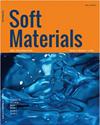Elastic instability and inflation modeling of an axially-loaded hyperelastic cylindrical thin shell
IF 1.4
4区 材料科学
Q4 MATERIALS SCIENCE, MULTIDISCIPLINARY
引用次数: 0
Abstract
ABSTRACTWhile inflating the thin-walled hyperelastic cylindrical cell, a localized type of instability occurs. After some deformation, the localization forms a bulge along the tube length. When a bulge reaches a specific diameter, it begins to spread axially. Such a phenomenon occurs at a single pressure value much lower than the pressure required to initiate the bulge. In this paper, we model such a phenomenon by predicting the effect of axial load on the value of limit pressure and bulge propagation pressure. In conjunction with existing experiments, we develop the model and determine the conditions that cause bulges to form and spread in an inflated thin cylindrical shell in the presence of an axial force. Using a newly proposed energy function, we demonstrate how axial tensile load influences bulge initiation and steady-state propagation in a thin cylindrical rubber shell. Experimental data and alternative models have both been used to validate the proposed mathematical model.KEYWORDS: Continuum mechanicshyperelasticityelastic instabilitycylindrical thin shells Disclosure StatementNo potential conflict of interest was reported by the author(s).轴向载荷超弹性圆柱薄壳弹性失稳与膨胀模型
摘要在对薄壁超弹性圆柱形电池进行充气时,会产生局部不稳定性。局部化后,沿管长方向形成凸起。当一个凸起达到一定的直径时,它开始向轴向扩散。这种现象发生在一个压力值远低于启动鼓泡所需的压力时。本文通过预测轴向载荷对极限压力值和膨胀扩展压力值的影响,建立了这种现象的模型。结合现有的实验,我们开发了模型,并确定了在轴向力存在的情况下,在膨胀的薄圆柱壳中形成和扩散的条件。利用一个新提出的能量函数,我们展示了轴向拉伸载荷如何影响薄圆柱形橡胶壳中的胀起和稳态传播。实验数据和替代模型都被用来验证所提出的数学模型。关键词:连续介质力学、超弹性、弹性不稳定性、圆柱薄壳披露声明作者未报告潜在的利益冲突。
本文章由计算机程序翻译,如有差异,请以英文原文为准。
求助全文
约1分钟内获得全文
求助全文
来源期刊

Soft Materials
工程技术-材料科学:综合
CiteScore
2.90
自引率
0.00%
发文量
21
审稿时长
2.2 months
期刊介绍:
Providing a common forum for all soft matter scientists, Soft Materials covers theory, simulation, and experimental research in this rapidly expanding and interdisciplinary field. As soft materials are often at the heart of modern technologies, soft matter science has implications and applications in many areas ranging from biology to engineering.
Unlike many journals which focus primarily on individual classes of materials or particular applications, Soft Materials draw on all physical, chemical, materials science, and biological aspects of soft matter. Featured topics include polymers, biomacromolecules, colloids, membranes, Langmuir-Blodgett films, liquid crystals, granular matter, soft interfaces, complex fluids, surfactants, gels, nanomaterials, self-organization, supramolecular science, molecular recognition, soft glasses, amphiphiles, foams, and active matter.
Truly international in scope, Soft Materials contains original research, invited reviews, in-depth technical tutorials, and book reviews.
 求助内容:
求助内容: 应助结果提醒方式:
应助结果提醒方式:


